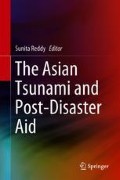Abstract
The global architecture of humanitarian aid is barely adequate to deal with mounting emergency situations arising out of natural and technological hazards, as well as civil and military conflicts. The Boxing Day Indian Ocean tsunami of 2004 was a notable exception; not only did the aid flow, it overflowed in many places and sectors. This was largely due to the exceptional nature of the catastrophe—in intensity, in magnitude and scale, in impact, in damage and loss, and in consequences—that spread across countries and continents. The decade-long experiences with tsunami aid—from pledges to releases, from releases to expenses, from expenses to recoveries and from recoveries to resilience—are well documented in the growing volume of literature on the subject. This chapter outlines the key lessons learnt in tsunami aid and its effectiveness. The lessons are presented in a framework for the management of humanitarian aid, from inception to execution, covering different phases of disaster risk management: from emergency relief and rehabilitation to long-term recovery and reconstruction; from reconstructing infrastructure and livelihoods to building resilience of communities and countries.
Access this chapter
Tax calculation will be finalised at checkout
Purchases are for personal use only
Notes
- 1.
- 2.
- 3.
- 4.
References
Barrientos, A., D. Hulme, and A. Shepherd. 2005. ‘Can Social Protection Tackle Chronic Poverty?’ The European Journal of Development Research 17(1).
Christoplos, Ian. 2006a. Links between Relief, Rehabilitation and Development in the Tsunami Response: A Synthesis of Initial Findings. London: Tsunami Evaluation Coalition (TEC).
Christoplos, Ian. 2006b. “The Elusive Window of Opportunity” for Risk Reduction in Post Disaster Recovery, UNISDR.
Development Initiatives. 2006. The Global Humanitarian Assistance. London: Discript Ltd.
Buchanan‐Smith, Margaret, and Simon Maxwell. 1994. Linking Relief and Development: An Introduction and Overview. IDS Bulletin 25(4).
Featherstone A., and C. Antequisa. 2014. Missed Again: Making Space for Partnership in the Typhoon Haiyan Response. Action Aid, CAFOD, Christian Aid, Oxfam GB.
Flint, Michael, and Hugh Goyder. 2006. Funding the Tsunami Response: A Synthesis of Initial Findings. London: Tsunami Evaluation Coalition (TEC).
GFDRR. 2012. Managing Disaster Risks for a Resilient Future: A Strategy for the Global Facility for Disaster Reduction and Recovery 2013–15. Washiington DC, USA.
Hastrup, F. 2011. Weathering the World: Recovery in the Wake of the Tsunami in a Tamil Nadu Fishing Village. Berghan Books.
IFRC. 2003. Principles and Good Practices of Humanitarian Donorship. Stockholm.
Kellet, J., A. Caravani, and F. Pichon. 2014. Financing Disaster Risk Reduction—Towards a Coherent and Comprehensive Approach. New York: UNDP.
Kennedy, Jim, Joseph Ashmore, Elizabeth Babister, and Ilan Kelman. 2008. The Meaning of ‘Build Back Better’: Evidence From Post Tsunami Aceh and Sri Lanka. Journal of Contingencies and Crisis Management 16(1).
Lindberg, M. 2014. Post Tsunami Recovery in Thailand: Socio-Cultural Responses. Routledge.
McGilvray, Dennis B., and Michele R. Gamburd. (2013) Tsunami Recovery in Sri Lanka: Ethnic and regional Dimensions. London: Routledge.
McKeon, Jock, and Harry Masyrafah. 2008. Post-tsunami Aid Effectiveness in Aceh: Proliferation and Coordination in Reconstruction. https://www.brookings.edu/research/post-tsunami-aid-effectiveness-in-aceh-proliferation-and-coordination-in-reconstruction. Accessed on 11 May 2016.
Minza, W. 2005. Gender and Changes in Tsunami-Affected Villages in Nanggroe Aceh Darussalam Province. Oxford: Oxfam GB.
Neumayer, Eric, and Thomas Plümper. 2007. The gendered nature of natural disasters: the impact of catastrophic events on the gender gap in life expectancy, 1981–2002. Annals of the Association of American Geographers 97 (3): 551–566.
Reddy, S. 2013. Clash of Waves: Post Tsunami Relief and Rehabilitation in Andaman and Nicobar Islands. Idos Books.
Saini, A. 2013. Post-Tsunami Socio-Cultural Changes among the Nccobarese: An Ethnography of the Nicobarese of the Southern Nicobarese Islands. Tata Institute of Social Sciences.
Shaw, R (ed.). 2006. Recovery from the Indian Ocean Tsunami Disasters. Emarald.
Telford, John, and John Cosgrave. 2006. Joint Evaluation of International Response to Indian Ocean Tsunami: Synthesis Report. London: Tsunami Evaluation Coalition (TEC).
UNISDR. 2015a. Making Development Sustainable: The Future of Disaster Risk Management. Global Assessment Report on Disaster Risk Reduction. Geneva, Switzerland
UNISDR (United Nations International Strategy for Disaster Reduction). 2015b. Sendai Framework for Disaster Risk Reduction 201-52030. http://www.wcdrr.org/uploads/Sendai_Framework_for_Disaster_Risk_Reduction_2015-2030.pdf. Accessed Apr 2015.
World Health Organization Regional Office for South East Asia. 2013. Tsunami 2004: A Comprehensive Analysis, vol. 1. New Delhi.
The World Bank. 2013. Post disaster need assessment. Washington DC, USA.
Author information
Authors and Affiliations
Corresponding author
Editor information
Editors and Affiliations
Rights and permissions
Copyright information
© 2018 Springer Nature Singapore Pte Ltd.
About this chapter
Cite this chapter
Dhar Chakrabarti, P.G. (2018). Tsunami Aid and Its Effectiveness. In: Reddy, S. (eds) The Asian Tsunami and Post-Disaster Aid. Springer, Singapore. https://doi.org/10.1007/978-981-13-0182-7_16
Download citation
DOI: https://doi.org/10.1007/978-981-13-0182-7_16
Published:
Publisher Name: Springer, Singapore
Print ISBN: 978-981-13-0181-0
Online ISBN: 978-981-13-0182-7
eBook Packages: Social SciencesSocial Sciences (R0)

